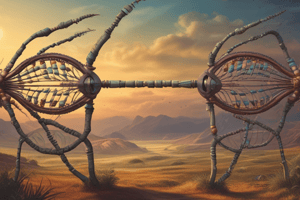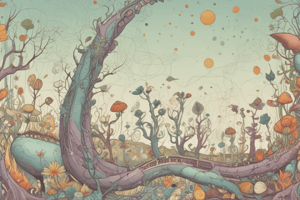Podcast
Questions and Answers
If a plant has a genotype of 'Aa' for stem height, where 'A' is the dominant allele for tall stems and 'a' is the recessive allele for short stems, what phenotype will the plant express?
If a plant has a genotype of 'Aa' for stem height, where 'A' is the dominant allele for tall stems and 'a' is the recessive allele for short stems, what phenotype will the plant express?
- Short stems
- An unpredictable stem height
- A blend of tall and short stems
- Tall stems (correct)
A scientist discovers a new gene in mice. Which of the following is the MOST direct function of this gene?
A scientist discovers a new gene in mice. Which of the following is the MOST direct function of this gene?
- Dictating the mouse's habitat preference.
- Influencing the mouse's learned behaviors.
- Coding for a specific protein that performs a function in the mouse. (correct)
- Determining the average lifespan of the mouse population.
In a pedigree chart, what does a shaded circle typically represent?
In a pedigree chart, what does a shaded circle typically represent?
- An unaffected male
- An unaffected female
- An affected female (correct)
- An affected male
Two heterozygous parents (Aa) are planning to have a child. Using a Punnett Square, what is the probability that their child will also be heterozygous (Aa)?
Two heterozygous parents (Aa) are planning to have a child. Using a Punnett Square, what is the probability that their child will also be heterozygous (Aa)?
Which process MOST directly contributes to genetic variation within a species?
Which process MOST directly contributes to genetic variation within a species?
A mutation occurs in a gene responsible for producing a critical enzyme. Which of the following is the MOST likely outcome?
A mutation occurs in a gene responsible for producing a critical enzyme. Which of the following is the MOST likely outcome?
Which of the following is an example of a trait?
Which of the following is an example of a trait?
If two parents, both with the genotype 'Bb' where 'B' is dominant for brown eyes and 'b' is recessive for blue eyes, have a child with blue eyes, what are the genotypes of the child?
If two parents, both with the genotype 'Bb' where 'B' is dominant for brown eyes and 'b' is recessive for blue eyes, have a child with blue eyes, what are the genotypes of the child?
If both parents are carriers of a recessive allele for a certain trait, but neither parent expresses the trait, what is the probability that their offspring will express the trait?
If both parents are carriers of a recessive allele for a certain trait, but neither parent expresses the trait, what is the probability that their offspring will express the trait?
Which of the following is the correct relationship between genes, chromosomes, and DNA?
Which of the following is the correct relationship between genes, chromosomes, and DNA?
In sexual reproduction, why do offspring exhibit genetic variation compared to their parents?
In sexual reproduction, why do offspring exhibit genetic variation compared to their parents?
A mutation in a gene results in a protein that functions differently, leading to increased muscle mass in an organism. This mutation would be considered:
A mutation in a gene results in a protein that functions differently, leading to increased muscle mass in an organism. This mutation would be considered:
A scientist is studying a population of bacteria. Some bacteria possess a mutation that makes them resistant to a particular antibiotic. What is the most likely outcome if the population is exposed to the antibiotic?
A scientist is studying a population of bacteria. Some bacteria possess a mutation that makes them resistant to a particular antibiotic. What is the most likely outcome if the population is exposed to the antibiotic?
In a Punnett square, what do the letters inside the boxes represent?
In a Punnett square, what do the letters inside the boxes represent?
A gene codes for a protein responsible for producing a specific pigment in a flower. A mutation occurs, preventing the protein from being produced. What is the most likely outcome?
A gene codes for a protein responsible for producing a specific pigment in a flower. A mutation occurs, preventing the protein from being produced. What is the most likely outcome?
Why is there greater variety in organisms that reproduce sexually compared to those that reproduce asexually?
Why is there greater variety in organisms that reproduce sexually compared to those that reproduce asexually?
If a mutation occurs in a parent's DNA during sexual reproduction, which of the following is most likely?
If a mutation occurs in a parent's DNA during sexual reproduction, which of the following is most likely?
Which of the following best describes the role of proteins in determining an organism's traits?
Which of the following best describes the role of proteins in determining an organism's traits?
Flashcards
Trait
Trait
A characteristic or feature of an organism.
Variation
Variation
Differences in traits among individuals of the same species.
Genotype
Genotype
The genetic makeup of an organism (e.g., AA, Aa, or aa).
Phenotype
Phenotype
Signup and view all the flashcards
Gene
Gene
Signup and view all the flashcards
Alleles
Alleles
Signup and view all the flashcards
Homozygous
Homozygous
Signup and view all the flashcards
Heterozygous
Heterozygous
Signup and view all the flashcards
Mutation
Mutation
Signup and view all the flashcards
Chromosome
Chromosome
Signup and view all the flashcards
Asexual Reproduction
Asexual Reproduction
Signup and view all the flashcards
Sexual Reproduction
Sexual Reproduction
Signup and view all the flashcards
Harmful Mutation
Harmful Mutation
Signup and view all the flashcards
Beneficial Mutation
Beneficial Mutation
Signup and view all the flashcards
Study Notes
- Trait: An inherited characteristic or feature of an organism.
- Variation: Differences in traits among individuals of the same species.
- Protein: Molecules coded by genes that perform essential functions in the body.
- Genotype: An organism's genetic makeup, indicated by allele combinations.
- Phenotype: An organism’s observable characteristics resulting from its genotype.
- Pedigree: A chart tracking trait inheritance across generations.
- Chromosomes: Thread-like structures in the nucleus containing genes.
- Sexual reproduction: Reproduction involving two parents, leading to genetic variation.
- Gene: A DNA segment that codes for a specific protein and determines traits.
- Alleles: Different versions of a gene; can be dominant or recessive.
- Nucleus: The part of the cell where genetic material is stored.
- Genetic information: Instructions in DNA that determine an organism’s traits.
- Genetic material: The DNA that carries hereditary information.
- Homozygous: Having two identical alleles for a gene.
- Heterozygous: Having two different alleles for a gene.
- Mutation: A change in a gene that may affect an organism’s traits.
- Heredity: The passing of genetic traits from parents to offspring.
- Dominant Alleles: Alleles that mask recessive alleles and determine the phenotype when present.
- Recessive Alleles: Alleles expressed only when no dominant allele is present.
- Dominant Traits: Traits appearing when at least one dominant allele is present.
- Recessive Traits: Traits appearing only when two recessive alleles are inherited.
- Punnett Square: Diagram used to predict offspring's genetic outcomes.
Key Concepts
- Offspring inherit traits via genes located on chromosomes.
- Each parent provides one allele per gene, forming a pair that determines traits.
- Dominant traits are expressed with just one dominant allele.
- Recessive traits appear only with two recessive alleles.
- Offspring may express more traits from a parent if those traits are dominant.
- A Punnett Square predicts genetic outcomes by showing allele combinations.
- Offspring can display hidden traits if both parents carry a recessive allele.
- Understanding alleles, genes, and chromosomes is crucial for predicting trait inheritance.
- Genotype is an organism’s genetic code.
- Phenotype is an organism’s observable traits.
- The combination of alleles determines an organism’s physical characteristics.
Heredity and Variation
- Reproduction is crucial role in heredity and variation.
- Asexual reproduction yields offspring genetically identical to the parent.
- Sexual reproduction combines genetic material from two parents, increasing genetic diversity.
- Mutations introduce new variations in a population.
- Mutations can be beneficial, harmful, or neutral based on their effect on protein function.
How to Use a Punnett Square
- Identify the alleles from each parent and place one parent's alleles along the top and the other’s along the side
- Fill in the squares to determine possible allele combinations.
- Use these results to determine genotype ratios and predict traits.
Genetic Relationships
- DNA contains genes, which provide instructions for making proteins.
- Genes are organized into chromosomes found in the cell nucleus.
- Proteins determine traits by influencing cell structure and function.
- Humans have 23 pairs of chromosomes, half from each parent.
- Genes come in different versions, called alleles, which can be either dominant or recessive.
Genes Make Proteins, and Proteins Control Traits
- Genes instruct cells how to make proteins.
- Proteins help build, fix, and control traits.
- Mutations are changes in a gene's DNA sequence that can alter proteins.
- Harmful mutations can cause diseases.
- Beneficial mutations aid survival.
- Neutral mutations have no significant effect.
Genetic Differences Between Parents and Offspring
- Offspring receive half of their genes from each parent.
- Each offspring has a unique gene combination due to the mixing of parental genes.
Sexual Reproduction and Inherited Genes
- Sexual reproduction involves both parents contributing half their genes.
- Offspring get two alleles per gene, one from each parent.
- Mutation in offspring can alter the protein produced, with varying effects.
- A model can show how gene mutations affect protein production.
Asexual vs. Sexual Reproduction
- Asexual reproduction creates identical offspring.
- Sexual reproduction creates offspring with new gene combinations, increasing variety organisms.
Studying That Suits You
Use AI to generate personalized quizzes and flashcards to suit your learning preferences.
Description
Explore fundamental concepts of genetics including traits, variations, genotypes, and phenotypes. Learn about genes, alleles, and how they determine inherited characteristics. Understand genetic material, and sexual reproduction. Also learn about pedigrees.





